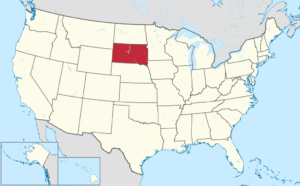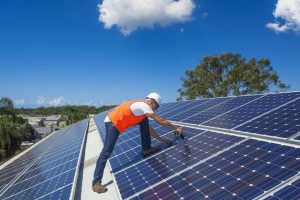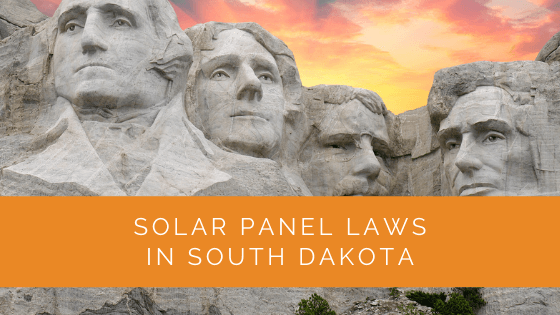 South Dakota has immense solar power potential, but strangely, the state currently stands last regarding installed solar power in the country.
South Dakota has immense solar power potential, but strangely, the state currently stands last regarding installed solar power in the country.
There are several reasons for this situation. One of the reasons could be the already lower-than-average cost of electricity in the state. The average cost of electricity in South Dakota is $0.10 per kilowatt-hour, which is less than the national average of $0.13 per kilowatt-hour.
Also, the state does not provide as many incentives for solar power as other states.
South Dakota has one of the best property tax exemptions for solar power installation in the whole country. Here’s a list of some of the major solar panel laws in South Dakota.
Contents
- 1 Key Takeaways
- 2 Net Metering
- 3 Federal Solar Tax Credit
- 4 South Dakota Solar Tax Credit
- 5 South Dakota Property Tax Exemption
- 6 South Dakota Interconnection Standard
- 7 Case Study: Residential Solar Installation in South Dakota
- 8 Expert Insights From Our Solar Panel Installers About Solar Panel Laws in South Dakota
- 9 Experience Solar Excellence with Us!
Key Takeaways
- South Dakota lags in solar power installation due to low electricity costs and limited state incentives.
- The state lacks a statewide net metering law, making solar power negotiations with utilities location-dependent and potentially less favorable for homeowners.
- Federal solar tax credits provide significant savings, currently at 30% of the system cost. However, these credits are gradually decreasing, and property tax exemptions in South Dakota can lead to substantial savings for solar panel owners.
Net Metering
Even though it’s a federal requirement, South Dakota is one of the only four states without a statewide net metering law. It simply means that net metering must be negotiated individually with the utility in that location.
Many other states offer net metering. Net metering means the utility will buy solar power from a household at the same retail rate that sells electricity to the buyers.
On the other hand, the wholesale net metering laws are less favorable for homeowners willing to install solar panels in South Dakota. As per this policy, the utilities buy electricity from the homeowners at the wholesale rate, the same rate at which they buy energy from wholesale electricity suppliers.
For instance, if a utility buys power at $0.04 per kilowatt-hour at wholesale rates from their supplier and sells it to consumers at $0.07 per kilowatt-hour, they will purchase solar power from the consumers for $0.04 per kilowatt-hour instead of $0.07 per kilowatt-hour.
States with favorable net metering policies force the utilities to buy solar power from consumers at the same price they sell it to consumers.

Federal Solar Tax Credit
The federal solar tax credits allow you to get significant savings on installing solar panels in South Dakota. It is known as investment tax credit or ITC.
Currently, the federal tax credits stand at 30% of the cost of the entire system. For instance, if you spend $25,000 on solar panel installation, you will get a federal solar investment tax credit of $7,500.
However, it would be best if you did it quickly as these credits are being phased out progressively, and the rate will decrease in the next few years.
Remember that you will not get a direct discount or a reduction in the solar panel installation cost, but you will get a tax credit, which means you can deduct it from the federal taxes you must pay.
As the numbers show, it is a considerable saving if you choose to go solar. It is important to mention that if you do not make enough money to take advantage of the tax credits in the first year, it is possible to split the amount over subsequent years for full compensation.
You should also know that this tax credit is only available to buyers who buy the whole solar system at once. You can always secure a solar loan if you cannot afford to spend this much on solar panel installation. Several providers offer solar loans.
South Dakota Solar Tax Credit
Most states provide solar tax credits as an incentive to encourage homeowners to install solar panels, but South Dakota does not have any state income tax, which means no solar tax credits.
South Dakota Property Tax Exemption
Everyone agrees that the property tax exemption available in South Dakota for solar panel installation is, hands down, the best in the whole country.
For solar power systems less than 5 kW, there are substantial property tax exemptions. The state offers property tax exemption on the first $50,000 or 70% of the assessed value of the property used for producing solar power, whichever is higher. This exemption is available for four years.
Let’s make things clear with an example.
Say your property is worth $200,000, and the property taxes on this property at the rate of 1.3% come to $2600. If you install solar panels on your property and the increased value of your property is now $220,000, you will be paying property taxes only 30% of the enhanced value of your property. In simple terms, your property taxes will come to:
Value of your property for property taxes after solar panel installation = $220,000 x 30% = $66,000
Property taxes on $66,000 @ 1.3% = $858
Annual Savings on property taxes = $2,600 – $858 = $1,742
You will save this much money annually on property taxes for four years.

South Dakota Interconnection Standard
There is a statewide interconnection standard in South Dakota. Everyone has to follow these two rules:
- All solar power systems need to have an external redundant disconnect switch.
- Also, all the homeowners who choose to go solar need to carry liability insurance.
This is why it is essential to partner with a trusted solar contractor aware of the extra interconnection requirements in South Dakota.
While South Dakota does not offer any special incentives for solar panel installation, the property tax exemption saves a lot of money, which gives a solid reason for you to go solar today.
Case Study: Residential Solar Installation in South Dakota
Background
In Rapid City, South Dakota, homeowners face unique challenges and opportunities when considering solar energy. Despite South Dakota’s lower electricity costs and limited state incentives, the significant property tax exemptions and federal tax credits create a compelling case for solar power adoption.
Project Overview
We were approached by a homeowner in Rapid City who wanted to reduce their electricity bills and leverage the available incentives for solar installation. Our goal was to install a 5 kW residential solar system tailored to their energy needs and rooftop specifications.
Implementation
Initial Assessment: Our process began with a detailed energy audit to understand the household’s historical data on electricity usage. This assessment helped us determine the appropriate system size, ensuring it matched the home’s energy consumption patterns.
Design and Planning: Using our expertise, we designed a solar system that maximized the available rooftop space. Our design also ensured the system’s components worked efficiently together.
Installation: The installation involved several meticulously planned steps. The solar panels were installed with precision, optimizing their position to capture maximum sunlight throughout the year.
Connection and Testing: Post-installation, we connected the system to the grid, navigating the local utility’s net metering policies. This involved configuring the system to handle the energy production and consumption effectively, ensuring compliance with South Dakota’s interconnection standards.
Results
Once operational, the solar system immediately began reducing the homeowner’s reliance on grid electricity. The performance monitoring showed a significant drop in monthly electricity bills.
In the first year alone, the homeowner saved approximately $1,000 on electricity costs. Additionally, the federal solar investment tax credit helped offset the initial installation costs, enhancing the system’s financial viability.
The property tax exemption available in South Dakota provided further savings. With the exemption covering 70% of the assessed value of the solar system for the first four years, the homeowner saw a significant reduction in their property tax bills.
Summary
This residential solar installation in Rapid City highlights the potential for solar energy in South Dakota despite the state’s limited incentives. By leveraging federal tax credits and substantial property tax exemptions, homeowners can achieve significant financial benefits. At Solar Panels Network USA, we are committed to delivering high-quality, customized solar solutions that help residents harness the sun’s power and contribute to a more sustainable future.
Expert Insights From Our Solar Panel Installers About Solar Panel Laws in South Dakota
Despite South Dakota’s lower-than-average electricity costs, homeowners are increasingly interested in solar power to take advantage of the significant property tax exemptions and federal tax credits available.
Lead Solar Installer
The lack of a statewide net metering law in South Dakota makes it essential for homeowners to negotiate terms individually with their utility providers. This can be challenging but is crucial for maximizing the financial benefits of solar power.
Senior Solar Technician
Federal solar tax credits provide a substantial incentive for South Dakota residents to install solar panels. With the current 30% credit on the total system cost, it’s a perfect time to invest in solar before these credits begin to phase out.
Solar Energy Consultant
Experience Solar Excellence with Us!
Trust in Solar Panels Network USA, where our seasoned experts deliver top-quality solar solutions for homes and businesses nationwide. With a legacy of countless successful installations and a commitment to sustainable energy, we’re your reliable partner in the solar journey. Ready for a brighter, eco-friendly future? Call us now at (855) 427-0058 and harness the power of the sun!
Map image by Wikimedia Commons User: TUBS / CC-BY-SA-3.0
About the Author
Solar Panels Network USA stands at the forefront of solar energy solutions, driven by a team of seasoned solar engineers and energy consultants. With over decades of experience in delivering high-quality solar installations and maintenance, we are committed to promoting sustainable energy through customer-centric, tailored solutions. Our articles reflect this commitment, crafted collaboratively by experts to provide accurate, up-to-date insights into solar technology, ensuring our readers are well-informed and empowered in their solar energy decisions.

